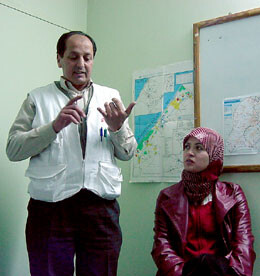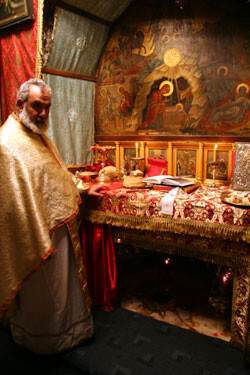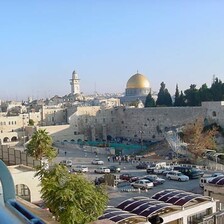Palestine 29 December 2005

Imad J. Tomaty, director of Terre des Hommes, speaks to the delegation (Dr. Bill Dienst)
March 8, 2005 Hebron and Bethlehem (Al-Khalil wa Bayt-lehem in Arabic) — Our bus uneventfully passes through Kiryat Arba’a, clears the northern checkpoint and curves around terraced Palestinian hillsides with fruit trees in spring bloom. In a roundabout way, we are back in the city of Hebron, but this time in a section of the city which is not under curfew; people are going about their daily business.
Terre Des Hommes
We tour a glass factory, and then disembark at the Hebron Community Mental Health Program sponsored by Terre des Hommes. We are met by Imad J. Tomazy, the program coordinator and his staff. Mr. Tomazy is a clinical psychologist who received his master’s degree at Al Quds University in Jerusalem. His office serves multiple purposes: it is a mental health counseling center, a social center, and an educational and advising center.
According to Mr. Tomazy, 40.5 percent of the children in the Hebron area have been exposed to severe violent trauma such as shootings and explosions, and 11.2 percent of the population have directly experienced war trauma themselves. With children, this results in psychosomatic symptoms such as somatization into chronic physical complaints that have no medical explanation, hyperactivity, nightmares, and bedwetting, amongst others. Symptoms can differ in boys and girls. Boys have an outlet by being out on the streets in demonstrations against the Israeli soldiers and throwing stones. The girls are often stuck at home with no outlet, and their psychological symptoms can be much worse than the boys.
Women are sometimes victims of domestic abuse compounded by the hopeless overall situation. Of the 140,000 Palestinians in Hebron, 20,000 women have been through empowerment classes that address coping with sexual abuse and violence. There are also classes for the general population which tackle coping with a hopeless future; they are taught coping strategies such as ‘knowing thy self’ and raising self-esteem. Sixty-five percent of the fathers in the Hebron area are currently unemployed. There are also classes for local Palestinian police officers emphasizing communications skills, and classes on religious counseling.
Medecins Sans Frontieres

Dr. Ghandi Tamimi, director of Medecins Sans Frontiers in Hebron, talks about the dire situation in his city (Dr. Bill Dienst)
MSF provides medical assistance, witnesses human tragedies, and documents human rights abuses. The Hebron area office currently staffs one social worker, two clinical psychologists and one local MD who is trained in primary care and emergency medicine.
Today, we are hosted by Carmen, from Spain, who is one of the psychologists, and Melveen who serves as a translator/mediator. She, along with Dr. Gandhi Tamimi, are Palestinians.
Doctor Tamimi explains how MSF operates within the current “Swiss Cheese” situation that is now Palestine. As stipulated by the 1997 Hebron Protocol, Hebron is divided into the H1 and H2 areas. The H2 segment is where the Jewish settlers live amongst the Palestinian population, and it is currently the segment of the city under curfew. Agoraphobia, the fear of leaving one’s home, is common amongst the Palestinian residents of H2. There they are surrounded by six settlements within the center of the city. The Palestinians in H2 become isolated within enclaves and are faced with daily harassment and violence. They become isolated from city services as well, and this is where MSF and the International Committee of the Red Cross/Crescent (ICRC) come in.
Dr. Tamimi explains, “Those who are killed are served by God. Those who are displaced are served by UNRWA [The United Nations Relief and Works Agency], and those who are isolated are served by the ICRC and MSF. Some are caught between Israeli Armored Vehicles and Sterile Buffer Zones around the settlements which include their neighborhoods.”
The Siege at the Church of the Nativity in Spring, 2002

The spot believed to be the birthplace of Jesus inside the Church of the Nativity in Bethlehem (Bob Haynes)
The columns of tanks entering Bethlehem backed up for blocks and there was no stopping them. According to Georges, young men were given the option of going home to their families, or staying to fight. About half stayed to fight.
As the tanks advanced on Manger Square, the fighters took refuge in the Church of the Nativity. There were 248 people trapped in the church. Seventeen international peace activists joined for a while and were later evacuated. Initially, spirits were good, as it was felt that a negotiated settlement would transpire within a week.
The besieged within the church received specific instructions from Yasser Arafat not to shoot from inside the church. Still, showing one’s face at a window was at the risk of being taken out by one of many Israeli snipers strategically positioned throughout Manger Square. Several others were killed trying to smuggle food inside to the priests and the fighters. All told, a total of nine were killed in this way, and their bodies were interned in the basement of the church until the end of the siege. Twenty-six were injured and evacuated, and most of them are still in jail, according to Georges.
The last ten days of the siege were the most difficult. The Israeli occupation forces blared loudspeakers and many suffered from nightmares. There were those suffering from bleeding. The last four to five days of the siege were spent without food. Finally those fighters deemed by the Israelis to be the most dangerous were deported in a deal to end the siege. Thirteen were deported to Europe and 30 to Gaza. After a month, they walked out of the church, right past their families. Their families were told that they would never see them again. Thirty of those evacuated from the Church were legal minors. It took quite a while to clean up the church with burned buildings and bullets embedded within the walls. Dum-dum bullets were used, which explode upon impact, producing more damage inside the victim, and also within the walls of the church.
Next, we spend a day in Gaza.
[NEXT…]
Dr. Bill Dienst is a rural family and emergency room physician from Omak, Washington, USA. In March 2005, he traveled to Palestine and Israel as part of a delegation sponsored by Washington State Physicians for Social Responsibility (WaPSR). The delegation met with prominent Palestinians as well as members of the Israeli peace movement. They also traveled inside the Kiryat Arba’a settlement to hear a prominent member of the settler movement. In this series of articles, Dr. Dienst describes these meetings. Dr. Dienst has been to Israel-Palestine twice before. In November 2003, he spent 10 days in Gaza sponsored by Gaza Community Health Programme, and in 1985, he spent 4 1/2 months in Egypt the West Bank and Gaza sponsored by the Palestine Red Crescent Society.





